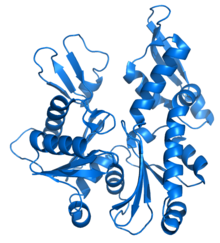This article includes a list of general references, but it lacks sufficient corresponding inline citations. (August 2019) |
MreB is a protein found in bacteria that has been identified as a homologue of actin, as indicated by similarities in tertiary structure and conservation of active site peptide sequence. The conservation of protein structure suggests the common ancestry of the cytoskeletal elements formed by actin, found in eukaryotes, and MreB, found in prokaryotes.[1] Indeed, recent studies have found that MreB proteins polymerize to form filaments that are similar to actin microfilaments. It has been shown to form multilayer sheets comprising diagonally interwoven filaments in the presence of ATP or GTP.[2]
| Cell shape determining protein MreB/Mbl | |||||||||
|---|---|---|---|---|---|---|---|---|---|
 | |||||||||
| Identifiers | |||||||||
| Symbol | MreB | ||||||||
| Pfam | PF06723 | ||||||||
| InterPro | IPR004753 | ||||||||
| CDD | cd10225 | ||||||||
| |||||||||
MreB along with MreC and MreD are named after the mre operon (murein formation gene cluster E) to which they all belong.[3]
Function
editMreB controls the width of rod-shaped bacteria, such as Escherichia coli. A mutant E. coli that creates defective MreB proteins will be spherical instead of rod-like. Also, most bacteria that are naturally spherical do not have the gene encoding MreB. Members of the Chlamydiota are a notable exception, as these bacteria utilize the protein for localized septal peptidoglycan synthesis.[4][5] Prokaryotes carrying the mreB gene can also be helical in shape. MreB has long been thought to form a helical filament underneath the cytoplasmic membrane, however, this model has been brought into question by three recent publications showing that filaments cannot be seen by electron cryotomography and that GFP-MreB can be seen as patches moving around the cell circumference. It has been shown to interact with several proteins that are proven to be involved in length growth (for instance PBP2). Therefore, it probably directs the synthesis and insertion of new peptidoglycan building units into the existing peptidoglycan layer to allow length growth of the bacteria.
References
edit- ^ Gunning PW, Ghoshdastider U, Whitaker S, Popp D, Robinson RC (June 2015). "The evolution of compositionally and functionally distinct actin filaments". Journal of Cell Science. 128 (11): 2009–2019. doi:10.1242/jcs.165563. PMID 25788699.
- ^ Popp D, Narita A, Maeda K, Fujisawa T, Ghoshdastider U, Iwasa M, et al. (May 2010). "Filament structure, organization, and dynamics in MreB sheets". The Journal of Biological Chemistry. 285 (21): 15858–15865. doi:10.1074/jbc.M109.095901. PMC 2871453. PMID 20223832.
- ^ Löwe, Jan; Amos, Linda A. (2017-05-11). Prokaryotic Cytoskeletons: Filamentous Protein Polymers Active in the Cytoplasm of Bacterial and Archaeal Cells. Springer. p. 255. ISBN 978-3-319-53047-5.
- ^ Ouellette SP, Karimova G, Subtil A, Ladant D (July 2012). "Chlamydia co-opts the rod shape-determining proteins MreB and Pbp2 for cell division". Molecular Microbiology. 85 (1): 164–178. doi:10.1111/j.1365-2958.2012.08100.x. PMID 22624979. S2CID 5568586.
- ^ Liechti G, Kuru E, Packiam M, Hsu YP, Tekkam S, Hall E, et al. (May 2016). "Pathogenic Chlamydia Lack a Classical Sacculus but Synthesize a Narrow, Mid-cell Peptidoglycan Ring, Regulated by MreB, for Cell Division". PLOS Pathogens. 12 (5): e1005590. doi:10.1371/journal.ppat.1005590. PMC 4856321. PMID 27144308.
Further reading
edit- Erickson HP (September 2001). "Cytoskeleton. Evolution in bacteria". Nature. 413 (6851): 30. Bibcode:2001Natur.413...30E. doi:10.1038/35092655. PMID 11544510. S2CID 4430479. - source of information added to this entry as of February 20, 2006
- Swulius MT, Chen S, Jane Ding H, Li Z, Briegel A, Pilhofer M, et al. (April 2011). "Long helical filaments are not seen encircling cells in electron cryotomograms of rod-shaped bacteria". Biochemical and Biophysical Research Communications. 407 (4): 650–655. doi:10.1016/j.bbrc.2011.03.062. PMC 3093302. PMID 21419100.
- Domínguez-Escobar J, Chastanet A, Crevenna AH, Fromion V, Wedlich-Söldner R, Carballido-López R (July 2011). "Processive movement of MreB-associated cell wall biosynthetic complexes in bacteria" (PDF). Science. 333 (6039): 225–228. Bibcode:2011Sci...333..225D. doi:10.1126/science.1203466. PMID 21636744. S2CID 45635270.
- Garner EC, Bernard R, Wang W, Zhuang X, Rudner DZ, Mitchison T (July 2011). "Coupled, circumferential motions of the cell wall synthesis machinery and MreB filaments in B. subtilis". Science. 333 (6039): 222–225. Bibcode:2011Sci...333..222G. doi:10.1126/science.1203285. PMC 3235694. PMID 21636745.